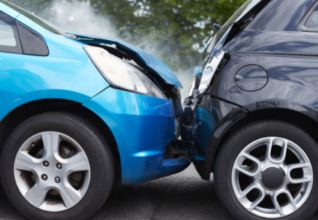The weather in Ireland can be prone to unpredictable changes that can be challenging for motorists. The cold, damp climate, frequently accompanied by rain, sleet, and sometimes snow, presents unique challenges for drivers on the roads.
In the colder, darker months, the likelihood of encountering wet or icy roads can be significantly higher. And drivers need to be acutely aware of the risks associated with driving in these conditions, particularly the danger of vehicle skidding.
What Causes A Vehicle To Skid?
Skidding occurs when your car’s tyres lose their grip on the road, leading to a loss of control. It can be a frightening experience, but by understanding the causes and knowing how to react, you can significantly reduce your risk.
Several factors, often combined, can lead to a loss of traction. Wet or icy conditions can play a significant role in increasing the risk of skidding. Additionally, other elements like the condition of the vehicle’s tyres, driving speed, braking habits, and potential mechanical issues can also contribute to this hazard.
Wet or Icy Conditions
Wet or Icy conditions are the most common cause of road skidding. After rainfall, the roads are left wet. The water can then build up on the road surface, making it very difficult for the tires to grip. The same goes for icy conditions. The lack of friction can lead to tires slipping on the road. You need to take extra caution when driving in wet or icy conditions. The Road Safety Authority (RSA) advises all drivers to adapt to these conditions by slowing down and increasing the braking distance between you and the vehicle in front to at least four seconds.
Worn or Bald Tires
Your tyres are the only part of your car in contact with the road, making their condition vital for safety. Bald or worn tyres are less able to grip the road and cannot clear water from the road surface effectively, which can lead to skidding or aquaplaning. Drivers should regularly check their tires for wear and replace them when necessary. The legal minimum tyre tread depth in Ireland is 1.6mm, but for winter driving, the RSA recommends a minimum of 3mm for a safer grip.
Driver Actions
Driver behaviour or sudden, careless manoeuvres can also lead to skidding. These include:
-
Speeding: Speeding on the roads is also a significant cause of skidding. Travelling too fast for the conditions makes it harder to control the vehicle and increases the chance of a skid. Drivers should always obey posted speed limits and reduce their speed in adverse weather conditions.
-
Braking: Abrupt or heavy braking can lock the wheels, causing a skid. You should always brake gently and smoothly, especially on wet or icy surface. You should avoid sudden braking whenever possible. Never break harshly in icy conditions, or you will likely skid off and lose control of the vehicle.
-
Steering: Sudden or sharp turns of the steering wheel can unbalance the car and cause the tyres to lose traction
Mechanical Issues
Lastly, a mechanical problem with the vehicle’s braking system, steering system, or suspension can also cause skidding. If you notice any unusual noises or vibrations while driving, you should get your vehicle inspected by a mechanic as soon as possible.
Modern Safety Technology
Most modern cars are equipped with advanced safety systems to help prevent skidding. While older systems like Anti-Lock Braking System (ABS) and Traction Control are now standard, the most important feature on new cars is Electronic Stability Control (ESC).
- ABS (Anti-Lock Braking System) helps to reduce the risk of skidding, which is caused by harsh or excessive braking.
- Traction control also helps to reduce skidding caused by excessive acceleration.
- ESC is considered to be the most significant advance in vehicle safety since the seatbelt. It works by automatically braking individual wheels to help stabilise the car if it detects a skid, helping you to maintain control.
Not all cars will have these features. These safety features are worth looking at if you’re in the market for a new car.
What to Do If You Start to Skid?
If your car begins to skid, the most important thing to do is not panic.
-
Look where you want to go: Your hands will tend to follow your eyes. Focus on the path you want to take, not the obstacle you are trying to avoid.
-
Steer into the skid: If the back of your car slides to the right, steer gently to the right. If it slides to the left, steer to the left. This helps to realign the car.
-
Do not brake heavily: Slamming on the brakes will likely make the skid worse. Release the brake pedal and allow the wheels to start turning again. Do not accelerate either.
Skidding can be caused by various factors, including wet or icy road conditions, worn or bald tires, speeding, sudden braking and mechanical problems. By understanding these factors and taking steps to prevent skidding, drivers can stay safe on the road and reduce the risk of accidents.
Looking to Save On Your Car Insurance?
At KennCo, our car insurance cover offers competitive rates and valuable benefits, including a replacement car as standard. Get peace of mind knowing you’re fully covered.
Get a Secure Quote Today
Several factors can cause a vehicle to skid. The most common causes are poor road conditions like rain or ice, worn tyres, driving too fast for the conditions and sudden driver actions like harsh braking or steering.
Wet or icy conditions reduce the friction between the tires and the road surface, making it difficult for tires to grip the road, which can lead to skidding.
Tires with worn treads or those that are bald have reduced grip on the road surface, making it easier for the vehicle to skid, especially in adverse weather conditions.
Speeding increases the difficulty of controlling the vehicle and can be particularly hazardous in wet or icy conditions, leading to a higher risk of skidding.
Sudden or harsh braking can cause the wheels to lock up, leading to skidding. It’s recommended to brake gently and smoothly to avoid this.
Yes, mechanical problems with the vehicle’s braking system, steering system, or suspension can also lead to skidding.
Newer car models may include features like ABS (Anti-Lock Braking System) and traction control, which help reduce the risk of skidding caused by harsh braking or excessive acceleration.
Drivers should be aware of the factors that cause skidding, such as road conditions and vehicle maintenance, and take appropriate precautions like driving at safe speeds, maintaining their vehicle, and using smooth braking techniques.
In winter, thread depth becomes more of a concern for drivers. While the legal minimum tread depth is 1.6mm, the Road Safety Authority recommends at least 3mm for winter driving to ensure a safe grip on wet and icy roads.
ESC is a modern safety feature that helps prevent skids. If the system detects a loss of control, it automatically applies the brakes to individual wheels to help stabilise the vehicle and keep it on its intended path.
Don’t panic. Take your feet off the pedals and steer gently in the direction you want the car to go. Avoid slamming on the brakes, as this will likely make the skid worse.
